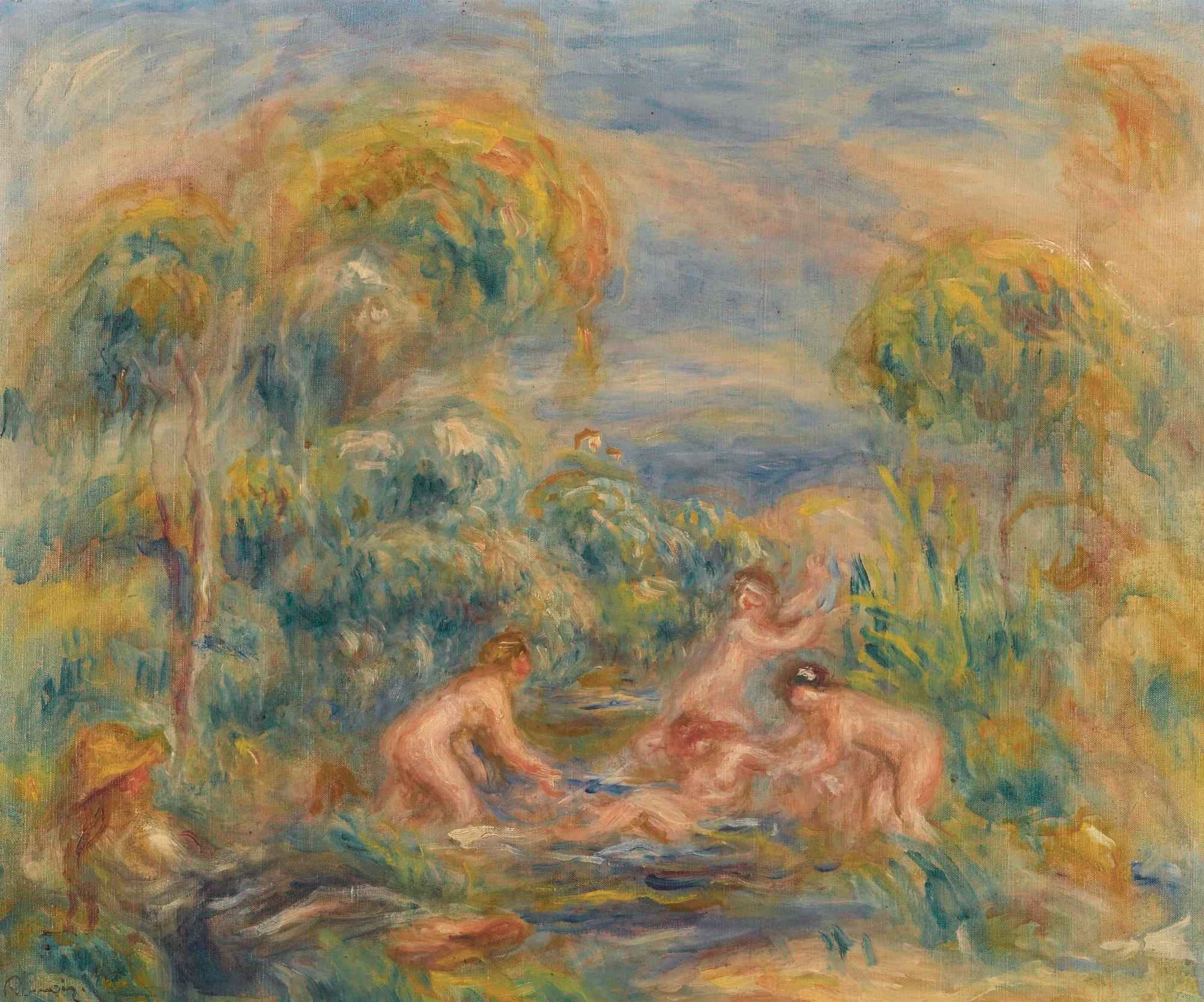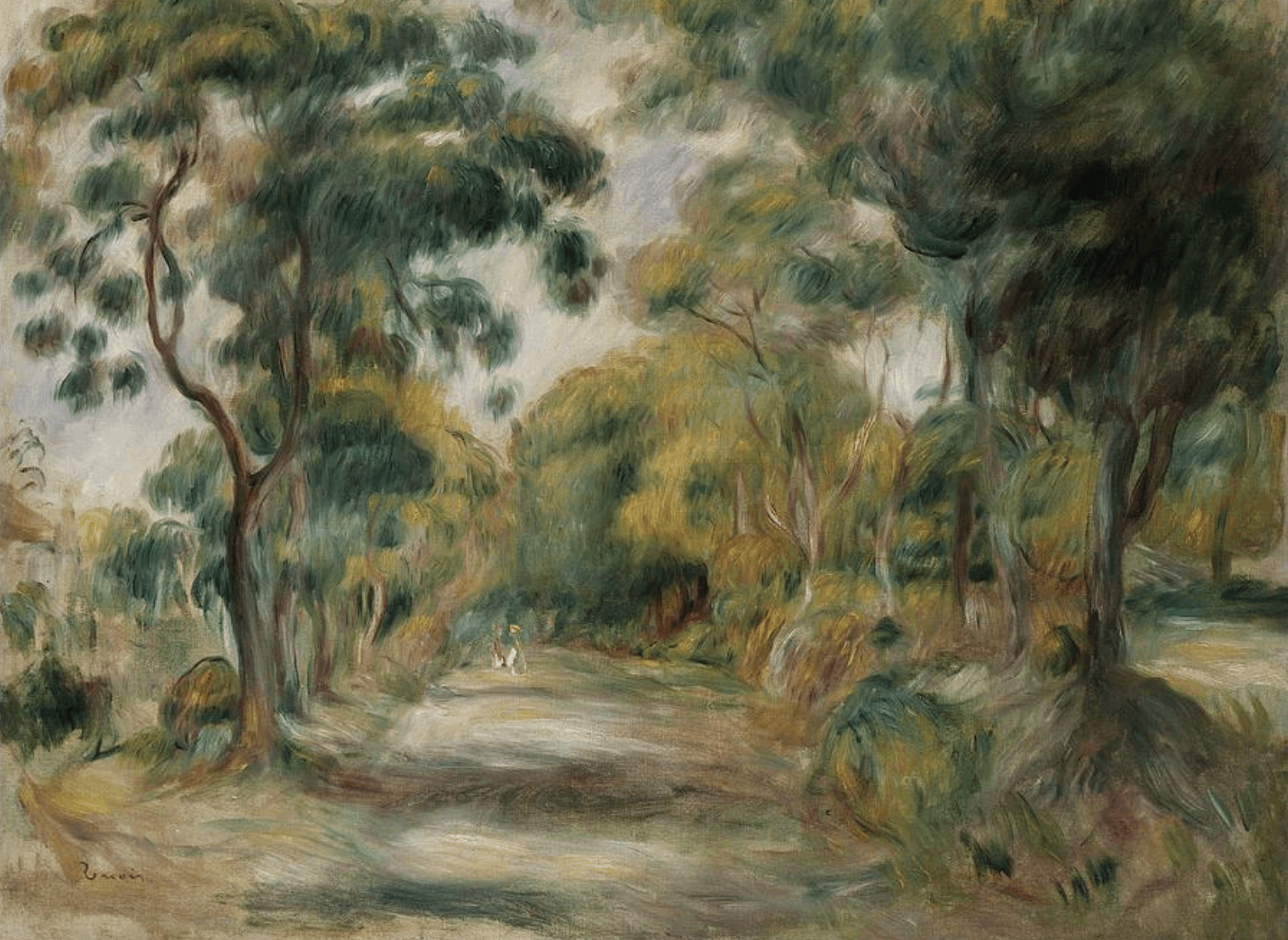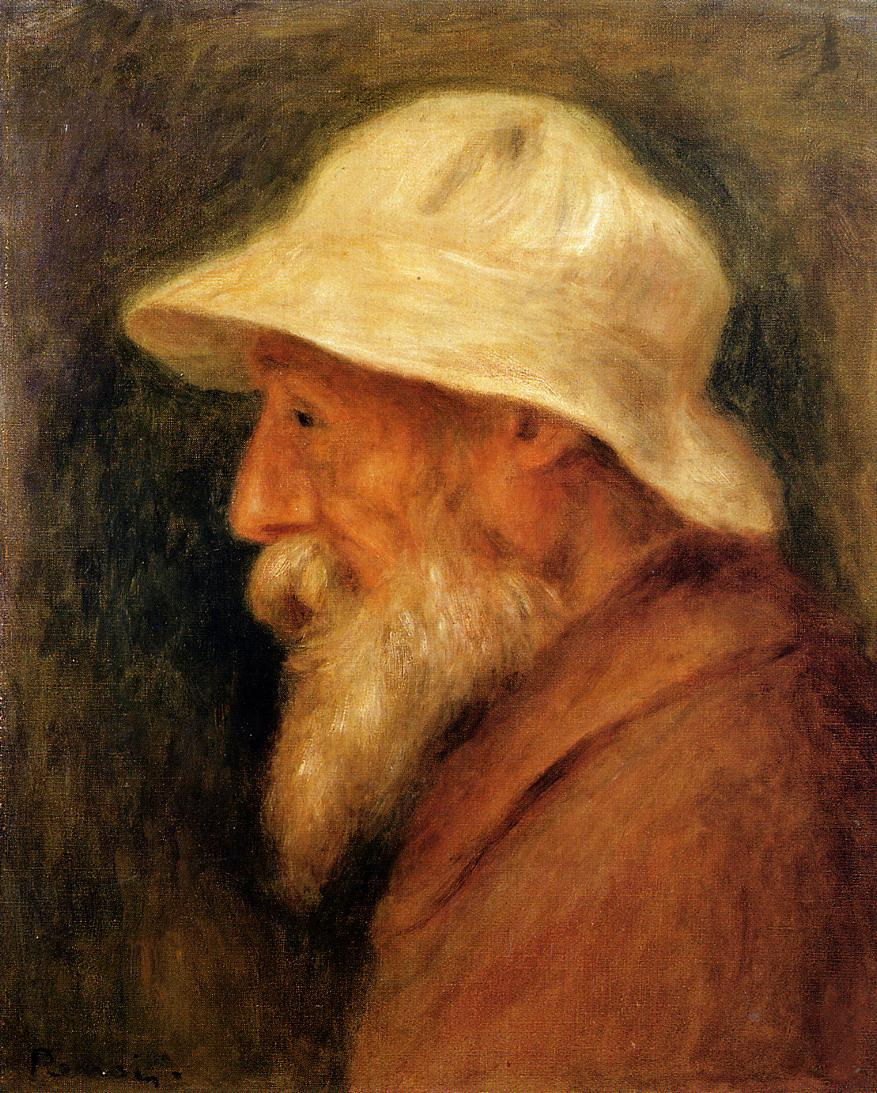르누아르 보기
To See Renoir
Text by 브루스 가니에 Bruce Gagnier
Translation by 박상미 Mimi Park
오귀스트 르누아르(1841-1919)의 작품, 특히 그의 누드를 보는 요즘의 시각*은 이 시대의 사회정치학적인 렌즈를 통해 형성된 것으로, 이는 그의 진정한 예술적 성취에 대한 평가를 흐리는 경향이 있다. 르누아르 시대의 예술적 과제나 그의 의도를 알지 못한 채 그의 작품을 이 시대의 맥락 속에 놓는다면, 미술사 속에서 뿌리 깊은 역사를 가진 이 ‘선의’의 이미지들이 실제로 무엇을 의미하는지 알기란 불가능하다. 낭만주의 시대의 자연주의적 시각, 그리고 누드에 대한 고대 예술의 개념에 기초한, 건강하고 자연스러운 인체는 우리가 갖고 있는 몸에 대한 이미지―과장되고 왜곡되기까지 한―와는 애초부터 큰 차이가 있다.
* 특히 ‘안티 르누아르,’ ‘신은 르누아르를 싫어한다’와 같은 일종의 혐오 트렌드

르누아르가 그린 누드는 우리 시대의 것이 아니다. 아마도 인간에 주어진 조건 중 소외되고 잊혀진 부분일 수도 있다. 르누아르의 누드는 본질적으로 감각적이지만 동시에 이상화된 형태로 볼 수 있다. 즉 작업실 상황에서 누드모델들이 갖는 ‘불균질irregular’한 성격과 그리스 조각이 갖는 고전적인 이상형에 모두 충실하기 때문이다. 화가로서 누드의 이러한 두 측면을 모두 고려한 것은 19세기 맥락으로 볼 때 충분히 있을 법한 상황이다. ‘드라이 시기 Dry Period’*라 불리는 힘든 시기를 겪으며 르누아르는 고전적 스타일을 성취하려는 노력을 하지만, 결국 자연(과 인간)의 불균질성을 향한 그의 애정을 추구하게 된다. 이 조합을 통해 르누아르는 당시 새로운 고전적 스타일의 화가로 앞서나가게 된다. 그의 회화의 추상적 측면―조형적 인식과 불균질성irregularity을 드러내는 왜곡―은 당시 실제 모델과 함께 작업하는 회화에 새로운 장을 열었고, 그 시대 새로운 조형적인 성과를 이루게 된다.
* 르누아르가 인상주의적 화법에 회의를 느끼고 고전적인 스타일의 회화에 집중하던 시기. 일명 앵그르 시기라고도 불린다.
르누아르가 다른 화가들에게 끼친 영향과 그들이 르누아르의 업적을 얼마나 크게 인정하고 있었는지에 관해서는 풍부한 증거가 있다. 그의 업적은 특별한 렌즈, 즉 조형성과 문화사를 볼 수 있는 안경을 끼고 보면 쉽게 볼 수 있을 것이다. 조형적 인식은 우리 시대의 평평해진 시각*, 정치적인 시각 속에서 점차 묻혀버렸다. 그림을 보는 관객들은 실제로 회화를 지배하는 내적 법칙을 통한 것이 아니라 그들이 가진 몸에 대한 이미지에 의해 영향받아 반응한다. 르누아르의 누드를 즉각적으로 비판하고 거부하는 이유는 우리의 눈이라는 평균적인 감각 기관이 뭔가 볼 수 있다고 생각하기 때문이다. 실제로 교육받지 않은 눈은 예술 작품을 볼 때 어느 수준 이상의 것을 볼 수 없는데 말이다.
* 우리의 눈은 점점 사진과 컴퓨터 스크린의 2차원적 평면에 익숙해져 3차원 지각이 힘들어지고 있다.
르누아르가 다른 화가들에게 끼친 영향과 그들이 르누아르의 업적을 얼마나 크게 인정하고 있었는지에 관해서는 풍부한 증거가 있다. 그의 업적은 특별한 렌즈, 즉 조형성과 문화사를 볼 수 있는 안경을 끼고 보면 쉽게 볼 수 있을 것이다. 조형적 인식은 우리 시대의 평평해진 시각*, 정치적인 시각 속에서 점차 묻혀버렸다. 그림을 보는 관객들은 실제로 회화를 지배하는 내적 법칙을 통한 것이 아니라 그들이 가진 몸에 대한 이미지에 의해 영향받아 반응한다. 르누아르의 누드를 즉각적으로 비판하고 거부하는 이유는 우리의 눈이라는 평균적인 감각 기관이 뭔가 볼 수 있다고 생각하기 때문이다. 실제로 교육받지 않은 눈은 예술 작품을 볼 때 어느 수준 이상의 것을 볼 수 없는데 말이다.

르누아르 회화를 제대로 감상하기 위해선 깊이 지각이 중요하다. 르누아르 그림에서 관객은 그림 속 인물의 다리나 둔부가 갖는 추상적인 부피감을 보게 되는데, 이는 단순히 명암의 조절을 통한 것이 아닌, 거의 마술적으로 행해진 직접적인 색의 조합과 조율에 의해 이루어진 것이다. 르누아르가 끊임없이 대가의 반열에 올려지는 것도 바로 이 이유 때문이다. 색 밑에 잠겨있는 드로잉과 그 위에 칠해진 깃털 같은 붓자국까지도 색채의 공간적 구성과 그 질량이 만드는 음악의 일부가 되며 형태를 암시하는 역할을 하고 있다. 이런 이유로 독일의 비평가 줄리어스 마이어 그라프는 형태와 공간감을 오직 색채로 이루어낸 일곱 명의 색채 화가 중 한 명으로 르누아르를 꼽고 있다.
촉각적 경험―눈으로 색을 눈으로 보고 느끼는 감각이 촉각으로 이어지는―은 르누아르 작품 감상에 있어 매우 두드러진 것이다. 우리는 색의 에너지를 심리적 차원뿐 아니라 공간적 차원에서 느낄 수 있도록 우리의 눈을 준비시켜야 한다. 색은 깊이 있는 공간 속에서 움직이기 때문이다. 캔버스 위에서 움직이는 붓자국은 부드럽지만, 침묵하진 않는다. 붓을 쥐고 있는 손은 캔버스에 직접 말하고, 우리에게도 단도직입적인 방식으로 말을 건넨다. 지나치게 우아하지도, 교육적이지도 않으면서 문화에 대한 기억이 만드는 깊이에 다다른다. 물감으로 말하는 르누아르의 목소리는 명료하고 이해하기 쉽다.

그림의 내용적인 측면에서 르누아르는 우리의 포르노적 시각이 치워두었던 그리스의 미적 이상을 추구하였다. 에로스와 이성의 합일, 그리고 순수의 순간을 표현하고 또한 살고자 하는 예술가의 욕망이 내재된 완벽한 순간을 찾으려 한 것이다. 이상적 아름다움에 다다르고자 하는 추상적 형태는 이 순간 실재real가 되었다. 젊은 여성의 성숙해가는 몸이 이 매개체로 사용된 것은 우리의 문화사가 낳은 미스터리로, 이제 우리는 시간 속에 이를 잃어버렸지만, 르누아르에게는 자연스러운 일이었다.
The view that forms the current opinion of Auguste Renoir, seen through a contemporary socio-political lens, tends to obscure his true artistic achievement, particularly his nude paintings. To place his work in the context of our time, without considering his artistic intentions, only blurs the meaning of these benign images embedded firmly in the history of painting. The healthy natural physiques based on the naturalism of the Romantic period, and his classical concept of the nude seem incongruous to our ideas of beings, which are often exaggerated, and even tortured in our own way.
EMBRACED THE “IRREGULARITY” + THE CLASSICAL IDEALIZATION IN THE NUDE PAINTINGS
These nudes are not of our time; possibly part of a marginalized aspect of the human condition. They are naturally sensual, and yet idealized, being true to both the “irregular” qualities of the life models in the studio, and the classical idealization of the Greek sculptures. These two aspects of conceiving the nude were very much within the artistic practice of the 19th century. While struggling through the “Dry Period,” changing his craft in a heroic attempt to achieve the classic style, he was ultimately able to embrace his love of irregularities in nature (including human nature) – in a synthesis which brought him up-to-date as a new classicist. His act of painting towards its abstraction—plastically conscious and yet distorted to his beloved irregularity— reimagined the practice of painting from life and marked a plastic achievement of his generation.
PLASTIC AWARENESS THAT WE NEED TO SEE RENOIR
There is ample evidence of Renoir’s influence on other painters and their total acceptance of him. This fact can be seen through a different set of spectacles, a pair tinted with plastic awareness as well as an understanding of a historical culture. The plastic consciousness is buried in contemporary culture, under a flattened vision and politics of seeing. It is most likely that the reaction of viewers is formed (or deformed) by their own ideas of the body, rather than informed by the internal laws of painting. Immediate criticism and rejection of Renoir’s nudes simply arise from the use of the normative eye apparatus assuming it sees just fine, while it doesn’t see anything in art on a certain level.
MODELED VOLUMIC FORM BY USING COLORS
It is crucial to be aware of depth in appreciating the paintings of Renoir. It can bring the viewer in contact with the abstraction of volume in a leg or hip, achieved not by modeling light and dark but by an almost magical, direct attack on color modulations which never succumb only to value. This constitutes his most important quality, one that consistently promotes him to the pantheon of great painters. The drawing submerged beneath the colors, and even the tactile feathery touch itself receded in the role of connoting form not only as a value structure, but the music of weight and spatial measure of color. The creation of volumes of flesh with color applied in feathery strokes brings to life the most advanced sensation the art of painting can induce. On this basis, Julius Meyer Graefe, a German art critic, put him in the pantheon of the seven great colorists who achieved a resonant sense of form and space with color alone.

ACHIEVED A SENSATION OF TOUCH BY THE MOVEMENT OF COLORS
The tactile experience –a sensation of touch through the mind and eye as communicated through color, is distinctively present in Renoir. One’s eye must be prepared to follow the energy of color, not just in the psychological dimension, but also in the spatial dimension as it moves in depth. The movement of the brush on the canvas is soft but not reticent; the hand that holds the brush speaks to the canvas, and then to us, in a simple, direct, straightforward way. It is never too graceful or pedantic while achieving depth of cultural memory. As a speaker in paint, Renoir is clear and easy to listen to.
THE IDEAL MADE REAL IN THE MOST PERFECT MOMENT
In his content, the profound meaning linked to the Greek idea of beauty has been set aside by a contemporary pornographic lens. Renoir seeks the perfect moment in a body, not only of the union of the erotic and the rational but of the epitome of the artist’s desire to express the moment of innocence, and to live in it. The abstraction of the ideal has been made real in the most perfect moment. The way a young woman’s blossoming body can be seen like such is one of the mysteries of a cultural acquisition, which is lost in the sands of time— but was, indeed, natural for Renoir.
RELATED POSTS
